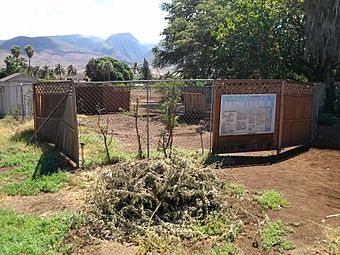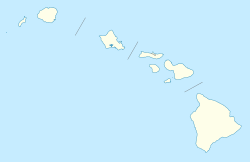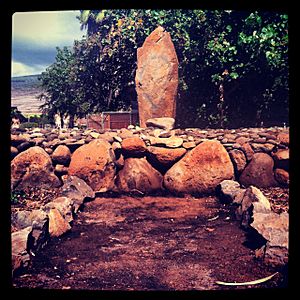Mokuʻula facts for kids
Mokuʻula is a small island in Lahaina, Hawaiʻi. Today, it is buried under a baseball field in Maluʻulu o Lele Park. This island was once the private home of King Kamehameha III. He lived there from 1837 to 1845.
Mokuʻula was also a special burial place for several Hawaiian royals. Many Hawaiians still consider the 1 acre (4,000 m²) island to be sacred. They see it as a piko, which means a symbolic center of energy and power. It was known as a peaceful place, even during the busy whaling days in the Pacific.
When the capital of Hawaiʻi moved from Lahaina to Honolulu, Mokuʻula was no longer used. Over time, it fell apart. By 1919, the land became a park. Later, a non-profit group was started to help bring the site back to life. Mokuʻula was added to the Hawaiʻi State Register of Historic Places in 1994. It was also added to the National Register of Historic Places in 1997. It is officially known as King Kamehameha III's Royal Residential Complex.
The Sacred Pond of Mokuhinia
Mokuʻula island was surrounded by a large pond called Mokuhinia. This pond was fed by natural springs and covered about 17 acres. People believed that Mokuhinia was home to Kihawahine. She was a powerful moʻo, or lizard goddess.
According to old stories, Kihawahine was a new form of Piʻilani's daughter, a chiefess named Kalaʻaiheana. Ancient Hawaiians used the pond to grow loʻi, which are patches for taro plants. They also built fishponds within Mokuhinia to raise fish.
Efforts to Restore Mokuʻula
A group called The Friends of Mokuʻula was created in 1990. This non-profit organization worked to restore the sacred site. Although the group is no longer active, they did important work.
From 1992 to 1995, and again in 1999, archaeologists studied the site. Experts from Bishop Museum and Heritage Surveys explored the area. They carefully recorded its features and boundaries. This work helped to understand the history of Mokuʻula.




